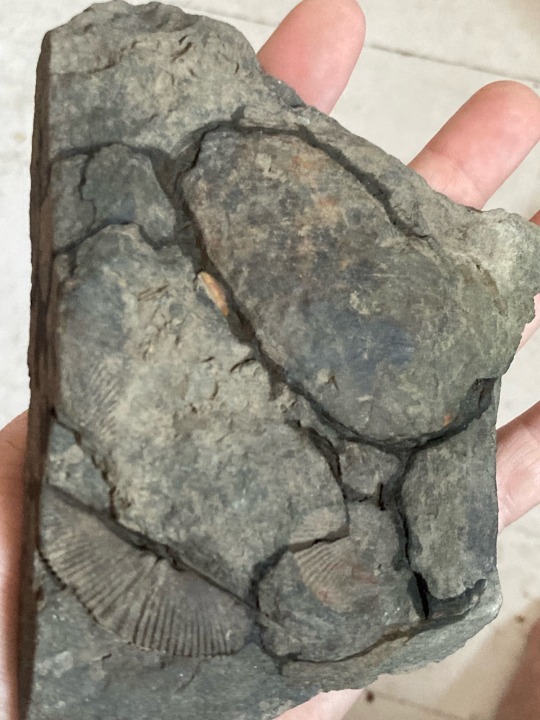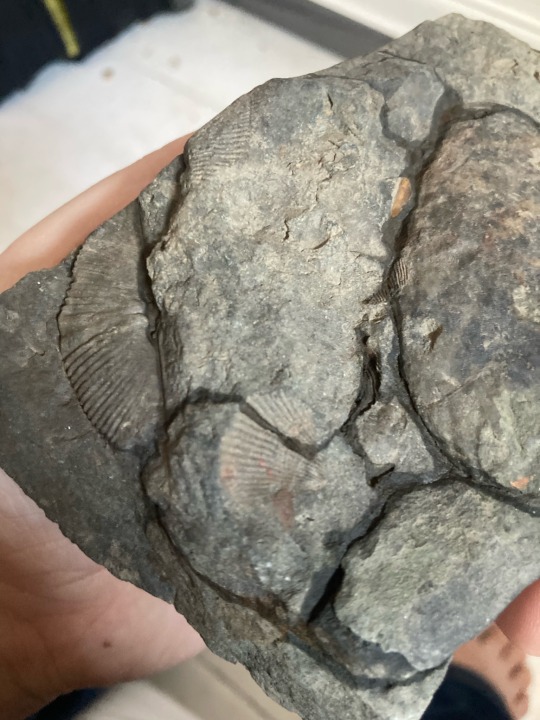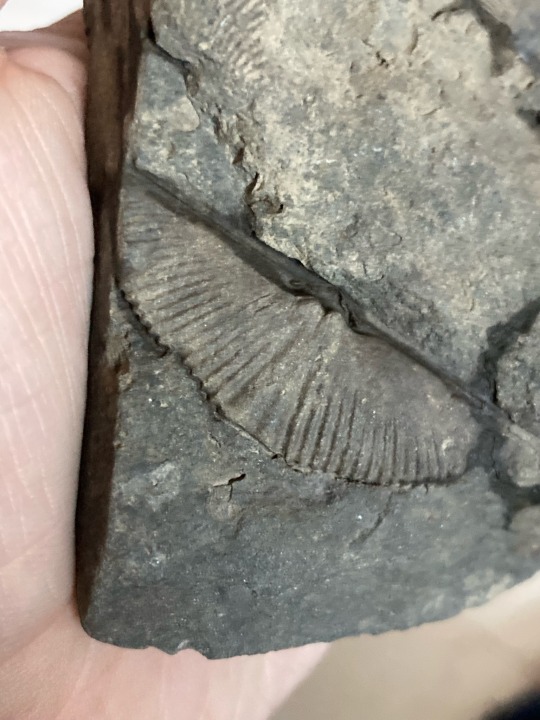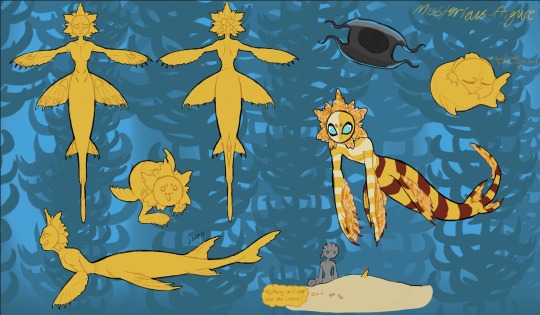#fossilized clam
Explore tagged Tumblr posts
Text



These are some of my favorite finds, fossilized buffalo bones and teeth, gastropod and my first complete bivalve. I found a bunch of shark teeth but they are all small. The ocean wasn't deep in central to North Texas.
1 note
·
View note
Text





;; Guys! Look what I found today!! Fossils!!! My inner child who dreamed of paleontology is screaming right now!
There’s a ton of shells, and the big rounded oval spot is a clam!!
#;; out of dreams (ooc)#fossils#fossil#paleontology#shell fossils#clam fossil#this is huge for me!!#im so excited!#I know these kinds of fossils are super common#and museums get a ton of these and don’t display them#so I’m definitely keeping it#but yeah!#I never found anything with this many fossils as a kid!#maybe the occasional one or two shell imprints#but not whole shells or a whole clam!
19 notes
·
View notes
Photo

Fossil Pectin Shell – Eocene Epoch, Clallam Bay Washington USA, Genuine Bivalve Specimen
A well-preserved Fossil Pectin Shell (scallop) from the Eocene Epoch, approximately 40–50 million years old. This specimen was collected from the Clallam Formation near Clallam Bay, Washington State, USA, a site known for producing beautifully preserved marine invertebrate fossils from the early Paleogene period.
Pectin shells belong to the family Pectinidae, a group of marine bivalves distinguished by their fan-shaped, radially ribbed shells. This fossil showcases the elegant symmetry and surface ribbing typical of this family, preserved in fine-grained sediment.
Fossil Type: Bivalve (Scallop) Shell
Geological Age: Eocene – Ypresian to Lutetian Stages
Formation: Clallam Formation
Depositional Environment: The Clallam Formation was deposited in a shallow marine environment along a continental shelf. Calm conditions and fine silts contributed to the exceptional preservation of molluscs, echinoderms, and other invertebrates in the fossil record.
Morphological Features:
Distinct fan-shaped shell outline
Radiating ribs across the surface
Some specimens retain hinge or growth lines
Notable:
Classic marine invertebrate from the Eocene of the Pacific Northwest
Ideal for educational displays, fossil collectors, or palaeontology enthusiasts
The photograph shows the exact item offered for sale
Authenticity: All of our fossils are 100% genuine natural specimens and come with a Certificate of Authenticity. Please refer to the scale image for exact size – each square or cube equals 1cm.
This Eocene Pectin shell from Clallam Bay offers a glimpse into the marine ecosystems of ancient Washington. A beautiful and scientifically valuable specimen for any fossil enthusiast.
#Pectin fossil#fossil bivalve shell#Eocene fossil USA#Clallam Bay fossil#scallop fossil#marine fossil shell#Washington State fossil#Pectinidae fossil#genuine fossil specimen#collector fossil shell#Eocene bivalve#fossil clam#authentic fossil scallop
0 notes
Text
#2769 - Solecurtus chattonensis

Synonyms for the genus include Adasius, Macha, Psammosolen and Solenocurtus.
Another fossil mollusc from the Late Oligocene. But the genus is still around, and living species outnumber the known extinct ones.
The best known species is probably the Rosy Razor Clam Solecurtus strigilatus, found in J-shaped burrows 50cm deep, in sandy seafloors of the Mediterranean and adjacent Atlantic, from near the shore to about 200m depth. Unusually for a bivalve, their soft body parts are too big to fit between the shells, and their main defence against predators is to burrow rapidly. They can also shed the tips of their inhalent and exhalent siphons, which pulse and twitch to distract whatever is trying to eat them.
University of Otago Geology Museum, Dunedin, Aotearoan New Zealand.
#Solecurtidae#Solecurtus#University of Otago Geology Museum#Dunedin#rosy razor clam#new zealand fossil#fossil#Dunedin NZ
0 notes
Text
2025 is off to a good start! I found my chert nodule with fossils in it after I lost it years ago 😭💕
It’s very special to me because it was the first and only fossil specimen I found on my property and not only that but chert with fossils in it is pretty rare!

I am SO happy! 💕💕💕💕💕💕💕💕💕💕🥰
#it was jammed in an odd spot in my car all this time!#It’s got lots of brachiopod shells and clams shells and from the devionian era#my land has lots of igneous and metamorphic material so sedimentary /anything/ is really hard to come by#rocks#fossils
1 note
·
View note
Text
I mean, being totally real with you, writing some strange fiction inspired by my childhood home would probably be extremely spooky and effective.
I lived in a pretty rural area of Ohio (that is no longer rural, lmao) and a lot of things that I grew up thinking were normal, like long-abandoned cemeteries and sea life frozen in the rocks outside my house, seem stranger now to adult eyes. I think I could write something fairly ghostly about the way that sometimes you almost feel like you hear words in the cornfields' whispers.
like. we passed this schoolhouse every day on my way to the new school. I think it's a museum now, but when I was a kid it was just like. sitting there.

I feel like there's something there! lmao
sometimes I look at certain fandoms and I think, "it would be sooooo fun to make something that makes people genuinely insane"
#I can't tell you how disappointed I was to move away from southwestern ohio as a child#and find out that other people didn't have shells and coral in their rocks the way we did#we were always digging fossilized clams and stuff out of our garden#which is kind of fun and interesting when everything around you is forest and cornfields
9 notes
·
View notes
Text
I made a little weekend trip to Fort Drum Florida to hunt for fossilized clams and in addition to finding a few great clam specimens I finally spotted a bird I’ve been wanting to photograph for years! Looked up from my fossil hole just in time to snap two quick photos as this beautiful crested caracara soared overhead


What an absolute gift to capture this bird!
209 notes
·
View notes
Photo

Crepidula Fossil Bivalve – Lower Miocene, Clallam Formation, Washington USA, Genuine Specimen
A genuine and well-preserved Crepidula fossil bivalve from the Lower Miocene epoch, approximately 16–20 million years old. This fossil was discovered in the Clallam Formation of Northwestern Washington, USA, an important geological unit known for preserving a diverse assemblage of marine molluscs.
The genus Crepidula, commonly known as slipper shells, is a marine gastropod mollusc (often mistaken for a bivalve due to its shell shape) with a distinctive internal shelf structure. This specimen reflects the shallow marine environments of the early Miocene in the Pacific Northwest.
Fossil Type: Gastropod (commonly called a slipper shell, not a true bivalve)
Genus: Crepidula
Geological Age: Lower Miocene (approx. 16–20 million years ago)
Formation: Clallam Formation
Depositional Environment: The Clallam Formation was deposited in a shallow, warm marine setting with good water circulation, supporting abundant marine life. The sediments include sandstone and siltstone beds that preserved mollusc shells in fine detail.
Morphological Features:
Convex outer shell with a smooth to slightly ridged surface
Internal “shelf” typical of Crepidula species visible in some specimens
Preservation may include original shell material or internal moulds
Notable:
Authentic specimen from the Clallam Formation, Washington State
A well-known genus with evolutionary and ecological interest
Ideal for fossil collectors, educators, and marine paleontology enthusiasts
Actual item shown – photo depicts the exact specimen you will receive
Authenticity: All of our fossils are 100% genuine natural specimens and come with a Certificate of Authenticity. The photo includes a 1cm scale cube for reference – please view the image for accurate sizing.
Add this genuine Crepidula fossil to your collection – a classic marine mollusc from the Lower Miocene seas of the Pacific Northwest, showcasing a beautifully preserved snapshot of ancient ocean life.
#Crepidula fossil#Miocene bivalve fossil#Clallam Formation fossil#Washington state fossil#fossil mollusc#fossil slipper shell#Crepidula fornicata#USA bivalve fossil#authentic fossil bivalve#collector fossil shell#fossil clam#lower Miocene fossil#Pacific Northwest fossil
0 notes
Text

Mer Sun.
Wobbegong + Angel shark + Brown-banded bamboo shark + Horn shark. Barely 4 ft long.
Sun lives in the same kelp forest as Moon. Those two often hang out together, as they have never found any others of their kind. Sun is an ambush predator. He buries himself in the sand and snags anything that strays to close (well, anything that isn't too big). He likes to crawl onto the beaches of near by islands and play in the warm, dry sand. And when he's done, he buries himself in it and takes a nap. He and Moon also love to go exploring on the islands. Moon is definitely the faster out of the duo. Both on land and in the water. But, he usually waits for Sun to catch up so he isn't left behind.
Funny little tidbit, Sun refuses to believe clams aren't moving rocks, no matter how many times Moon tells him. Sun has never seen the inside of a clam before. Moon doesn't know how to break them open, so he can't really prove his point. Even if Moon tries to show Sun a clam's shell, Sun just says that clams are fossil rocks (they have found fossils inside rocks on the beaches of some of the islands that they explore) and that the shell is the fossil inside. The two get into this argument a lot.
#fnaf dca#dca au#fnaf au#mermaid au#fnaf sun#dca sun#mer sun#shark sun#dca mer au#digital art#kelp forest friends
548 notes
·
View notes
Text
not to brag but


omg omg omg omg omg—
For Christmas my work friend got me one of those buckets with sand + rocks in them for sifting and she was like "oh I hope it's not too childish! I know you like rocks" and now I get to tell her that this was an amazing experience and I imagined i was an old timey miner and I found a shit ton of rocks in there and I am king of the world
#ooc#these photos may not do them justice but I am in heaven#THERE ARE A BUNCH OF CLAM FOSSILS TOO!! LIL FRIENDS!!!
10 notes
·
View notes
Text
Round 2 - Arthropoda - Pycnogonida




(Sources - 1, 2, 3, 4)
Pycnogonida is a class containing one order: Pantopoda, which means “all feet.” A fitting name for creatures that seem to be made entirely of legs. Commonly called “Sea Spiders”, they are not spiders, nor are they arachnids, but are actually a sister group to all other living arthropods.
Pycnogonids live in most oceans. Most are tiny, living in relatively shallow water, though some can grow to be quite large in antarctic and deep waters. Some pycnogonids are so small that each of their muscles consists of a single cell. They have a proboscis which they use to suck nutrients from soft bodied invertebrates such as cnidarians, sponges, polychaetes, and bryozoans. They can also insert their proboscis into anemones, though this rarely kills the anemone. The pycnogonid digestive tract extends into their legs. They are segmented, with the first body segment (the cephalon) consisting of the proboscis, the ocular tubercle with up to 4 simple eyes, a pair of chelifores, a pair of palps, a pair of ovigers, and the first pair of walking legs. Ovigers are used for cleaning themselves, courtship, and caring for eggs and young. Nymphonidae is the only family where both the chelifores and palps (sensory organs) remain functional. In others, these limbs are reduced or absent, instead relying on a well-developed and flexible proboscis equipped with sensory bristles. Pycnogonids are usually comprised of eight walking legs, but the family Pycnogonidae includes species with ten, and the families Colossendeidae and Nymphonidae include species with up to twelve legs! While most species have up to 4 eyes, some deep-sea species lack them entirely. Pycnogonids do not have a traditional respiratory system, instead absorbing oxygen through their legs and diffusing it throughout their body via hemolymph. Their small, long, thin hearts beat vigorously at 90 to 180 beats per minute, creating substantial blood pressure. Their nervous system consists of a brain which is connected to two ventral nerve cords, which in turn connect to specific nerves. Like other arthropods, they molt their exoskeleton as they grow.
Pycnogonid reproduction involves external fertilization after a brief courtship involving the male stroking the larger female with his ovigers and receiving the eggs if she is responsive. The couple must adjust their position until the genital pores on their legs are perfectly aligned. Only males will care for eggs and young, and in some species only the males will have ovigers while the females do not, as these limbs are used mainly for carrying and cleaning the eggs. Larvae consist only of a head with chelifores, palps and ovigers. Extra segments and legs emerge as it grows into an adult. There are at least four different types of larvae. The typical protonymphon larva is most common, is free living and gradually turns into an adult. The encysted larva spends its larval days as a parasite, finding a host in a colony of polyps, burrowing into one, turning into a cyst, and not leaving the host until it has become a juvenile. The atypical protonymphon larva lives on or within a temporary host such as a clam or polychaete worm, does not encyst or otherwise harm their host, and leaves them as an adult. Lastly, the attaching larva hatches as an embryo and immediately clings to the legs of its father, only leaving once it has two or three pairs of its own walking legs.
The pycnogonid’s cerebral appendages are unique, not found anywhere else among arthropods, except in fossils like Anomalocaris. This could mean that pycnogonids are the last surviving (highly modified) members of an ancient stem group of arthropods that lived in Cambrian oceans.

Propaganda under the cut:
They are good dads. All of them. Perfect fathers made of legs.
Their leg arrangement allows them to move forward, backward, and sideways without turning their body.
The genus Colossendeis (image 2) includes the largest pycnogonids, which live in the ocean depths. Some of them are even bioluminescent! The largest is Colossendeis colossea which can reach a leg span of 70 cm (28 in). However, their body length, including proboscis and abdomen, only reaches 7 cm (2.8 in).
About 20% of the known species of pycnogonids live in Antarctica. The cold never bothered them anyway.
One known species, Ascorhynchus corderoi, is hermaphroditic, having both ovaries and testes.
178 notes
·
View notes
Text

some little things from the beach today: pieces of ammonite fossils, small clam fossils, a crinoid (star!) fossil, part of a james keiller & sons dundee marmalade ceramic jar, a piece of grapeshot (or case shot?), a mermaid's purse, and a pretty piece of red glass
#thoughts#many more interesting things the whole beach was basically covered with them but i only had like an hour & the tide was coming i#there were also many big things like. a whole antique radiator rusting between rocks. etc#i plan to go back though
101 notes
·
View notes
Text
Calcite after Clam fossils from Rucks Pit, Florida, Found in the Nashua Formation, these gems are a window into Florida’s Pleistocene past.
🎥📹The Focal Crystal
88 notes
·
View notes
Text
i like to leave my fossil bivalves lying around bc people will see them, panic about wtf a clam is doing on the counter holy fuck it’s gonna smell, and then get mad at me bc it’s literally just rock and i tricked them once again
91 notes
·
View notes
Text

🐚 My Shell List for Ocean Witchcraft
very long!
Cowrie Shell -- Prosperity, fertility, feminine energy, wealth - where to collect: Africa, Indian Ocean beaches
Scallop Shell -- Journey, pilgrimage blessings, protection - where to collect: Atlantic beaches (USA, Europe)
Conch Shell -- Call to spirits, awakening inner power, amplifying voice - where to collect: Caribbean, warm tropical beaches
Sand Dollar -- Spiritual rebirth, peace, trust in universal cycles - where to collect: Mexico, Florida, tropical sandy shores
Murex Shell -- Royalty, sacredness, defense magic - where to collect: Mediterranean, Indo-Pacific
Olive Shell -- Grace, smooth paths, grounding wishes - where to collect: Southeastern US, Australia
Auger Shell -- Psychic defense, focus, clarity - where to collect: Indo-Pacific, Florida, warm beaches
Wentletrap Shell -- Spirit communication, delicate energy, accessing dreams - where to collect: Shallow waters, Southeast Asia
Babylon Shell -- Abundance, rootedness, wisdom of ancestors - where to collect: Persian Gulf, India, Philippines
Triton’s Trumpet -- Powerful protection, summoning sea spirits, strength - where to collect: Indo-Pacific reefs, coral-heavy shores
Limpet Shell -- Adaptability, steady progress, emotional protection - where to collect: Rocky shores, tide pools worldwide
Nerite Shell -- New beginnings, resisting negativity, safe travels - where to collect: Caribbean, Florida, Indo-Pacific
Moon Snail Shell -- Intuition, hidden wisdom, psychic dreams - where to collect: Pacific Northwest (USA), colder beaches
Top Shell -- Personal growth, creativity, positive flow - where to collect: Mediterranean, Caribbean
Turritella Shell -- Ancient memory, ancestral connection, earth-sea balance - where to collect: Fossil beds, warm shallow waters
Sundial Shell (Architectonica perspectiva) -- Cosmic connection, time magic, spiraling growth - where to collect: Indo-Pacific, sandy shallow areas
Helmet Shell (some of my favorites!) -- Courage, spiritual shielding, warrior energy - where to collect: Indo-Pacific, Caribbean
Volute Shell -- Love, devotion, honoring vows (Great gift for your partner <3) - where to collect: Warm waters, Indian Ocean
Paper Nautilus (Argonaut Shell) -- Creativity, femininity, magical flight - where to collect: These are rarer than most, and they float! Mediterranean, Australia
Angel Wing Shell -- Fragile beauty, spiritual awakening, connection to dreams - where to collect: Gulf of Mexico, Florida, Caribbean
Slipper Limpet -- Subtle healing, balance between giving and receiving - where to collect: European and East Coast shores
Donax Shell (Coquina) -- Energy shifts, playfulness, social magic - where to collect: Southeastern USA beaches
Cockle Shell -- Friendship, love, carrying home’s blessings - where to collect: European beaches, Atlantic shores
Pheasant Shell -- Endurance, adaptability, balance of inner and outer selves - where to collect: Australia, New Zealand, Pacific beaches
Spindle Shell -- Manifestation of goals, swift change, ambition - where to collect: Indo-Pacific region, tropical beaches
Marginella Shell -- Financial luck, small blessings, quick positive changes - where to collect: West Africa, Indian Ocean
Ark Shell (clam) -- Courage to face emotional challenges, opening the heart - where to collect: East Coast USA, Gulf of Mexico
Cat’s Eye Shell (Operculum) (My favorite!!!) -- Spiritual gateway, protection during astral travel - where to collect: Washed up with dead shells (Sri Lanka, Australia)
Button Top Shell -- Inner balance, softening harsh emotions, emotional maturity - where to collect: Caribbean, Indo-Pacific
✨ Tips for Collecting Shells
Respect local laws: Some places protect shells, corals, and marine wildlife! Always check if it's okay to take them.
Ethical gathering: Only take empty, dead shells (never with a creature still inside).
Cleanse shells: Wash gently with water and sea salt before using them in spells or altars.
🐚 Shell Magic Ideas
Use cowrie shells in money bowls.
Sand dollars are amazing for transformation rituals.
Conch shells can be used as literal horns to call spirits or start a ritual.
Tiny auger shells make great protection charms to wear or carry.
Paper nautilus shells (if you can find one!!) are perfect for creativity and dream weaving magic.
other sites to use: Shelling tips , shell hunting in Texas , Where and when to find shells
Note: some shells match certain moon phases! Do extra research before using, and make sure the ones you're taking aren't still alive or home to a hermit crab! that can be a miniature trouble! especially if the snail inside is possibly poisonous or venomous.
#shells#sea shells#seashells#aquatic#pagan witch#witch#witch community#witchblr#witches#witchy#witchcraft#witchy vibes#wicca#wiccan#pagan#witches of tumblr#sea witch#ocean witch#ocean witchcraft#ocean water#ocean world#ocean shells#where to find#seashell#Sand dollar#tips#cowrie#scallop#conch#sealife
29 notes
·
View notes
